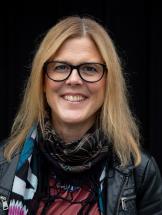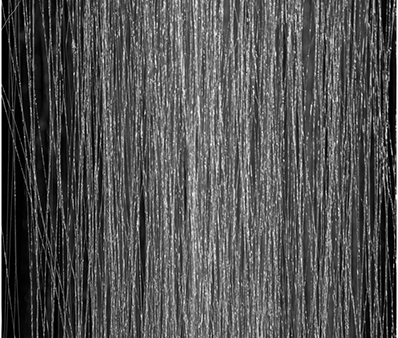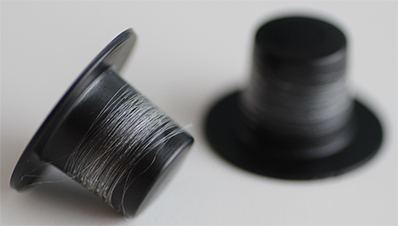Anna Rising

Presentation
About me
My basic degree is doctor of veterinary medicine, and I graduated from SLU in 2003. After working as a veterinarian a few years, I decided to get a PhD and joined an EU project, which aimed at producing artificial spider silk for medical applications. The project started with me going on an “adventure trip” to South Africa to collect 100 spiders in the wild. Since then, I am fascinated by this impressive material, and the spiders that produce it.
In 2007 I received my PhD, and soon after we started the company Spiber Technologies AB to commercialise our research findings. I was CEO from 2008 to 2012. In 2011-2017 I worked as an Assistant Professor at Karolinska Institutet, where I still work part time, and as an Extension Specialist/Senior Lecturer in Translational Medicine at SLU. Since 2018 I am professor of veterinay medical biochemistry at SLU and in 2024 I was appointed Wallenberg Scholar.

Research and area of expertise
My research area and area of expertise include biomimicr, bioinspired materials, regenerative medicine, molecular biotechnology and medical biochemistry.
We can artificially synthesize spider silk fibers that are as tough as native spider silk fibers which makes them highly interesting as replacements for petroleum based (plastic) fibers. Our production method is biomimetic, meaning that it is completely water based and void of denaturing chemicals and high temperatures. We focus basic studies of the silk producing organs in spiders, on scaling up the production of artificial spider silk, develop fibers for the textile industry and use fibers and hydrogels for project related to regenerative medicine (tissue repair).

Photo: Andersson, Jia et al. Nature Chemical Biology 2017
In another project we study a specific part, NT, of the spider silk protein, which increases the solubility of the spider silk proteins when they are stored in the spider’s silk glands. The solubility enhancing properties of NT apply also when NT is fused to other proteins with low solubility. Therefore, we use NT to produce protein drugs, which today are difficult or impossible to manufacture.
The spider silk proteins we produce form transparent hydrogels when the temperature is increased to 37 degrees. This discovery is now being developed further in projects related to injectable materials and as aplatform for immobilizing different proteins in a 3D matrix (Arndt et al. Nat Commun. 2022; Arndt, Chatterjee et al. Adv Funct Mater. 2023)

Photo: Andersson, Jia et al. Nature Chemical Biology 2017
Current research
My research has several main focuses:
1. To make artificial spider silk replicas.
2. To use spider silk to regenerate damaged tissue and to be able to culture stem cells under defined conditions
3. to use Nature’s own solubility increasing domain (NT) to develop poorly soluble proteins (drugs).
4. to explore how spiders spin their silk and make better biomimetic silk fibers and bioinspired solutions for the life science industry

Photo: Andersson, Jia et al. Nature Chemical Biology 2017
Research problems
How does the spiders' silk glands manage to produce extreme amounts of proteins and store them without encountering problems associated with premature aggregation?
Can we spin artificial spider silk fibers with the same mechanical properties as the natural spider silk fiber?
Can artificially produced spider silk be used as implants to replace damaged tissues and organs?
Can NT be used for the production of valuable and aggregation prone proteins with low solubility?
Film 1. Artificial spiderweb is made when a proteinKonstgjord spindeltråd som bildas när en proteinlösning sprutas ut i en buffrad vattenlösning. Publicerad av: Anna Rising & Jan Johansson (Sveriges lantbruksuniversitet & Karolinska Institutet). Källa: Andersson et.al., Biomimetic spinning of artificial spider silk from a chimeric minispidroin, Nature Chemical Biology, http://dx.doi.org/10.1038/nchembio.2269.
Film 2. Konstgjord spindeltråd rullas upp på en roterande ram i luften. Publicerad av: Anna Rising & Jan Johansson (Sveriges lantbruksuniversitet & Karolinska Institutet). Källa: Andersson et.al., Biomimetic spinning of artificial spider silk from a chimeric minispidroin, Nature Chemical Biology, http://dx.doi.org/10.1038/nchembio.2269.
The fibers are being collected onto motorized wheels, see movie published in Schmuck et al. Materials Today. 2021:
https://www.sciencedirect.com/science/article/pii/S1369702121002546#m0010
More information:

Photo: Andersson, Jia et al. Nature Chemical Biology 2017
My research colleagues
I share my time between the Swedish University of Agricultural Sciences (SLU) and Karolinska Institutet (KI).
SLU: Viktoria Langwallner, Tomás Bohn Pessatti, Gabriele Greco, Elin Karlsson, Karin Tufvesson, Benjamin Schmuck, Johan Reimegård (SciLife Lab)
KI: Olga Shilkova, Tobias Fietze
We work in close collaboration with Jan Johansson (KI) for protein biochemistry realted questions, and with:
Kristaps Jaudzems (LiOS, Riga), NMR spectroscopy
Michael Landreh (KI), Mass spectrometry
Yael Politi (Technical U of Dresden), FIB-SEM, XRF, SAXS and WAXS
Lena Holm (SLU), histology
Nicola Pugno (Trento U, Italien), Native spider silk, mechanical testing of fibers
Extension
Spider silk has long been used in folk medicine. I aim to use spider silk in the treatment of diseases and injuries, for which there is no or poor treatment options available due to the lack of suitable materials. I also work to facilitate production of protein-based drugs together with a pharmaceutical company.
By close collaborations with national and international partners in industry and at universities, my research will benefit society at large.
Our research has been on public display at exhibitions at Nobel Museum in Stockholm, Arbetets Museum in Norrköping, Skansen Aquarium (Skansen-Akvariet), Sweden, the World Expo 2010 in Shanghai, and Paris Natural History Museum, 2011-2012.

Photo: Marlene Andersson
Teaching
I teach on the programme in Veterinary Medicine at SLU
Other professional activities
Co-founder, Spiber Technologies AB
Senior Researcher, Karolinska Institutet
Advisory Board, “Chemical Mechanisms of Life” a Center of Excellence at the Uppsala University
Current Funding
Knut och Alice Wallenberg Foundation (Wallenberg Scholar)
Olle Engkvist Stiftelse
Europeiska forskningsrådet (ERC) Consolidator grant
ERC Proof of Concept grant
Vetenskapsrådet
Formas
Knut och Alice Wallenberg Foundation (DDLS-WASP)
CIMED (Stockholms Läns Landsting, Huddinge Kommun, Karolinska Institutet)
For details and past funding please check my ORCID, link can be found further down under Links
Read more
https://www.svt.se/nyheter/vetenskap/ny-upptackt-sa-spinner-spindeln-sitt-starka-nat
National News in SVT, Rapport, July 2021: https://www.svt.se/nyheter/inrikes/forskning-om-konstgjord-spindeltrad-gar-framat
Dagens Nyheter, Aug 2021: https://www.dn.se/sverige/sa-har-forskarna-tagit-fram-12-mil-konstgjord-spindeltrad/
TV4 Nyhetsmorgon. Interview. Sep 15, 2017. https://www.tv4.se/nyhetsmorgon/klipp/är-du-nya-spindelmannen-3934570
BBC. Interview. Sep 2017. http://www.bbc.co.uk/programmes/w3csv3dw
RadioScience. Podcast. 2016. http://www.radioscience.se/tag/anna-rising/
Spinning like a spider. Academia Net. Interview Sep 11, 2017. http://www.academia-net.org/news/spinning-like-a-spider/1500585
Silk gland mimic spins strong fibres. Nature. 541, 137. Jan 12, 2017. doi:10.1038/541137b
http://www.nyteknik.se/innovation/sa-hittade-de-nyckeln-till-konstgjord-spindeltrad-6817138
http://www.csmonitor.com/Science/2017/0111/How-did-scientists-create-the-strongest-artificial-spider-silk-yet
http://www.seeker.com/device-spins-super-strong-spider-silk-that-could-one-day-repair-nerves-2186281478.html
http://www.forbes.com/sites/carmendrahl/2017/01/09/scientists-have-finally-figured-out-how-to-spin-artificial-silk-the-way-spiders-do/#6812607c3880
http://www.wsj.com/articles/new-synthetic-spider-silk-offers-wound-stitching-potential-researchers-say-1484049601
https://www.researchgate.net/blog/post/spinning-super-strong-synthetic-spider-silk
http://www.unt.se/nyheter/uppsala/uppsalaforskare-gor-varldens-starkaste-spindeltrad-4497162.aspx
http://www.livescience.com/57458-strong-spider-silk-produced.html
Selected publications
Arndt T, Chatterjee U, Shilkova O, Francis J, Lundkvist J, Johansson D, Schmuck B, Greco G, Ekblad Nordberg Å, Li Y, Wahlberg LU, Langton M, Johansson J, Götherström C, Rising A. Tunable recombinant spider silk protein hydrogels for drug release and 3D cell culture. Advanced Functional Materials. 2023. https://doi.org/10.1002/adfm.202303622
Leppert A, Chen G, Lama D, Sahin C, Railaite V, Shilkova O, Arndt T, Marklund E, Lane D, Rising A, Landreh M. Liquid-Liquid Phase Separation Primes Spider Silk Proteins for Fiber Formation via a Conditional Sticker Domain. Nano Letters. 2023, 23, 12, 5836–5841.
Rising A, Harrington M. Biological materials processing: Time-tested tricks for sustainable fiber production. Chemical Reviews. 2023 Mar 8;123(5):2155-2199.
Schmuck B, Greco G, Bohn Pessatti T, Sonavane S, Langwallner V, Arndt T, Rising A. Strategies for making high-performance artificial spider silk fibers. Advanced Functional Materials. Online Oct 10, 2023. https://onlinelibrary.wiley.com/doi/full/10.1002/adfm.202305040
Arndt T, Jaudzems K, Shilkova O, Francis J, Johansson M, Laity PR, Sahin C, Chatterjee U, Kronqvist N, Barajas-Ledesma E, Kumar R, Chen G, Strömberg R, Abelein A, Langton M, Landreh M, Barth, Holland C, Johansson J, Rising A. Spidroin N-terminal domain forms amyloid-like fibril based hydrogels and provides a protein immobilization platform. Nature Communications. 2022. 13(1): 1-14.
Arndt T, Greco G, Schmuck B, Bunz J, Shilkova O, Francis J, Pugno NM, Jaudzems K, Berth A, Johansson J, Rising A. Engineered spider silk proteins for biomimetic spinning of fibers with toughness equal to spider dragline silks. Adv Funct Mater. 2022. Mar 25; https://doi.org/10.1002/adfm.202200986
Schmuck B, Greco G, Barth A, Pugno NM, Johansson J, Rising A.High-yield production of a super-soluble miniature spidroin for biomimetic high-performance materials. Materials Today. 2021. https://authors.elsevier.com/sd/article/S1369-7021(21)00254-6
Rising A & Johansson J.Doing what spiders cannot - a road map to supreme artificial silk fibers. ACS Nano. 2021. Feb 23;15(2):1952-1959.
Otikovs M, Andersson M, Jia Q, Nordling K, Meng Q, Andreas LB, Pintacuda G, Johansson J, Rising A, Jaudzems K. Degree of biomimicry of artificial spider silk spinning assessed by NMR spectroscopy. Angew Chem Int Ed Engl. 2017. Oct 2; 56(41):12571-12575.
Andersson, M., Jia, Q., Abella, A., Lee, X-Y., Landreh, M., Purhonen, P., Hebert, H., Tenje, M., Robinson, C. V., Meng, Q., Plaza, G.R., Johansson, J., Rising, A. Biomimetic spinning of artificial spider silk from a chimeric minispidroin. Nature Chemical Biology. 2017 Mar;13(3):262-264
Kronqvist N, Sarr M, Lindqvist A, Nordling K, Otikovs M, Venturi L, Pioselli B, Purhonen P, Landreh M, Sjöberg L, Robinson CV, Pelizzi N, Jörnvall H, Hebert H, Jaudzems K, Curstedt T, Rising A, Johansson J. Efficient protein production inspired by how spiders make silk. Nature Communications. 2017 May 23;8:15504
Rising A, Johansson J. Towards spinning artificial spider silk. Nature Chemical Biology. 2015. May; 11(15):309-15.
Kronqvist, N., Otikovs, M., Chmyrov, V., Chen, G., Andersson M., Nordling, K., Landreh, M., Sarr, M., Jörnvall, H, Wennmalm, S., Widengren, J., Meng, Q., Rising, A., Otzen, D., Knight, S. D., Jaudzems, K., Johansson, J. Sequential pH-driven dimerization and stabilization of the N-terminal domain enables rapid spider silk formation Nature Communications. 2014. DOI:10.1038/ncomms4254
Andersson M, Chen G, Otikovs M, Landreh M, Nordling K, Kronqvist N, Westermark P, Jörnvall H, Knight S, Ridderstråle Y, Holm L, Meng Q, Jaudzems K, Chesler M, Johansson J, Rising A. Carbonic Anhydrase Generates CO2 and H+ That Drive Spider Silk Formation Via Opposite Effects on the Terminal Domains. PLoS Biology. 2014 Aug 5;12(8):e1001921
Wu S, Johansson J, Damdimopoulou P, Shahsavani M, Falk A, Hovatta O,Rising A. Spider silk for xeno-free long-term self-renewal and differentiation of human pluripotent stem cells. Biomaterials. 2014 Oct;35(30):8496-502.
Lewicka, M., Hermanson, O., Rising, A. Recombinant spider silk matrices for neural stem cell cultures. Biomaterials, 2012. 33(31):7712-7717
Askarieh, G., Hedhammar, M., Nordling, K., Saenz, A., Casals, C., Rising, A., Johansson J., Knight S.D. Self-assembly of spider silk proteins is controlled by a pH-sensitive relay. Nature. 2010, 465:236-239.
Links
Publications list:
